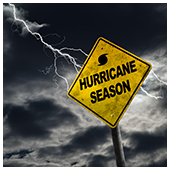 While it’s easy to turn a blind eye against hurricane warnings and think “I already have a business continuity plan in place”, it pays to be extremely cautious, especially when the National Oceanic and Atmospheric Administration (NOAA) predicts up to four unusually active hurricanes this year. Needless to say, you simply can’t afford not to hurricane-proof your disaster recovery (DR) plan.
While it’s easy to turn a blind eye against hurricane warnings and think “I already have a business continuity plan in place”, it pays to be extremely cautious, especially when the National Oceanic and Atmospheric Administration (NOAA) predicts up to four unusually active hurricanes this year. Needless to say, you simply can’t afford not to hurricane-proof your disaster recovery (DR) plan.
The NOAA forecasts 11 to 17 tropical storms in the Atlantic, the Caribbean Sea, and the Gulf of Mexico. Hurricane season has officially begun and is expected to last until the end of November. The four allegedly active hurricanes are presumed to be Category 3, 4, or 5 on the Saffir-Simpson Hurricane Wind Scale (Category 1 is the weakest and 5 the strongest).
But don’t panic just yet; here are five steps you can take to protect your business during hurricane season.
1. Schedule a DR drill
Despite having a DR plan, many companies don’t test their plan, at least not as often as they should. So if you’re one of those companies, it’s crucial to conduct a DR drill now. A lot can change in the months or years since you have last tested your plan -- systems updates, infrastructure upgrades, employee turnover and more. By scheduling a drill, you’ll be able to make sure everyone knows their roles and that all critical systems are covered.
Note that you should try to perform desktop walkthrough exercises, operational tests, and simulated recovery exercises on a regular basis.
2. Make sure your staff are prepared
All your staff should know what the evacuation procedures are as well as their responsibilities in the DR process. If not, coordinate with HR to make sure everyone in your company understands what the plan of action is for hurricane season. Staff with specific responsibilities need to get the documentation needed to effectively manage their roles in the event of a hurricane.
Set meetings with your DR team and schedule training for new team members. Your DR team should be able to quickly mobilize other employees to the DR site before bad weather hits. Don’t forget to touch base with any providers you are supposed to work with in case of an emergency, too.
3. Secure your backup site
In addition to a secondary location for data storage, your DR plan should also include another backup site so that you can continue your operations. In the event of a hurricane, dedicated space is imperative since your backup sites will likely be occupied with employees.
You should also consider the redundancy of utilities at your DR site, making sure you have enough power feed, fiber carriers, and anything else you’ll need to remain operational.
4. Check for amenities at your DR site
Whether your DR site is in the hurricane zone or in the nearest city, chances are hotels will be overbooked as people fight for a place to stay. This means your staff will likely be stuck onsite around the clock, so you need to make sure there is enough amenities to get them through this hectic period. Is there a place for employees to shower and sleep? Is there enough food and water to last them for at least a couple of days? These amenities will help your staff pull through as they restore your operations.
5. Update your DR plan’s appendix
Your DR plan should have an appendix with contact information, SLAs, and systems inventories information. More importantly, this information needs to be up-to-date; the last thing you need is calling your IT vendor when a server goes down only to reach the wrong number.
Go through all critical information in your DR plan and add any other information as needed. Vendors and shipper's contact information are a must as they will guarantee that you get hardware and power supplies backup without any hassles.
Unlike a fire drill which can be conducted on a yearly basis, your business continuity and disaster recovery plan needs to be tested regularly to meet your company’s changing needs. If you don’t already have a DR plan, or have any further questions, don’t hesitate to give us a call.
